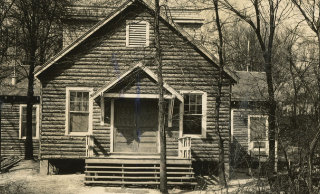✕
Our journey: The evolution of the Burroughs campus

Enrollment: 310 in 1930 & 307 in 1939
National Impact
- Head of school Wilford M. Aikin was appointed Chairman of the Directory Committee of the “Eight Year Study” initiated by the Commission on the Relations of School and College; a consortium of 30 schools that came together to compel reform to high school curricula in partnership with select colleges and universities.
- Throughout the 1930s, and as part of the Eight Year Study, Burroughs expanded its curriculum, built its core courses around central themes, and introduced innovations within and between departments. The innovations developed by Burroughs faculty came to be widely recognized in educational circles throughout the United States.
- In 1932, under the Eight Year Study, many participating colleges agreed to release the thirty cooperating schools (including Burroughs) from entrance requirements to study ways of serving young people more effectively.
- In 1935, Mr. Leonard D. Haertter was chosen to succeed Mr. Aikin as head of school, allowing Aikin more time to devote to the Eight Year Study.
Community Highlights
- Despite the Great Depression, tuition remained stable, scholarships continued to be awarded, and Burroughs was able to operate with a modest surplus. In 1932, enrollment was 292 and nearly 50 percent of students received some form of tuition aid.
- In 1931, the Fathers’ Council was founded. The Mothers’ Council followed in 1936. Both were precursors to the present-day Parents Council.
Program Highlights
- In 1932, Burroughs defeated Country Day (Codasco) in football for the first time, and athletics adopted the “Burroughs Bombers” moniker. Several years later, our mascot was revisited in a 1935 name-the-team contest which included alternatives such as the Hill-billies, the Killers, or the Goons. Fortunately, The World declared that “Bombers” would prevail, and all varsity teams were henceforth known as the Bombers.
- Richard W. Horner ’32 was named a Rhodes Scholar, the first Burroughs alum to receive this prestigious scholarship. Established in 1902, the Rhodes Scholarship is the oldest graduate scholarship in the world. It is considered among the most prestigious international scholarship programs.
- During the 1935-1936 school year, Burroughs won the ABC League Championship for the first time with 6,149 points, the highest score ever recorded.
- Painting and sculpture, at first taught by part-time instructors, were elevated by faculty, including Mrs. Caroline Everett Risque Janis, a beloved sculptor and renowned ceramicist. Mrs. Mabel Meeker Edsall joined the staff in 1931 to teach painting as a working artist.
- Katherine Blackman ’32 and Richard Duhme ’32 modeled and cast the bas relief figures that visitors see coming into and out of the dining room under the direction of Mrs. Janis.
- In 1935, the Carnegie Institute selected the John Burroughs Art Department for special recognition as one of the four finest art departments in the United States.
- The Review transitioned to look more like a yearbook for the Class of 1936. The name changed from The Review to The Governor in 1964 to honor the legacy of Dr. Leonard D. Haertter when he retired as head of school after nearly 30 years of service.